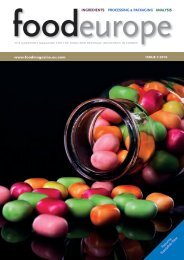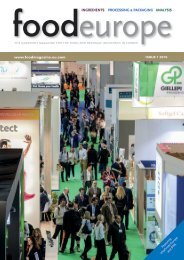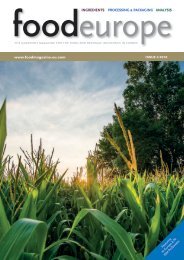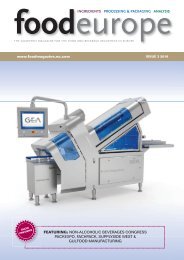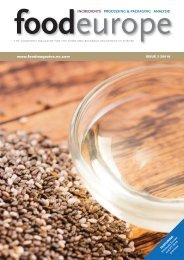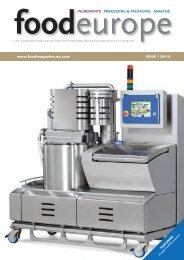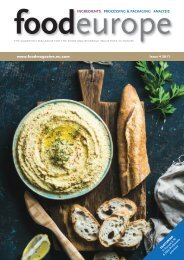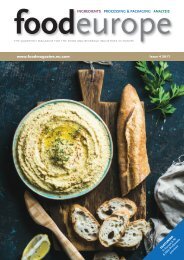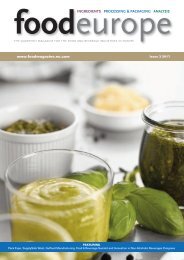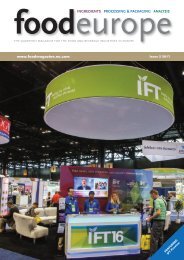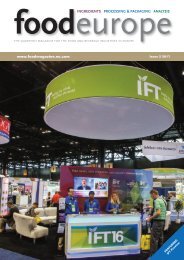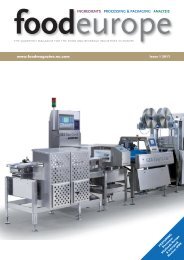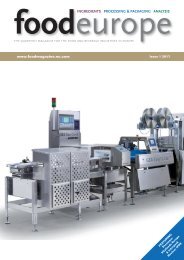food
You also want an ePaper? Increase the reach of your titles
YUMPU automatically turns print PDFs into web optimized ePapers that Google loves.
packaging<br />
27<br />
Coated film gets rid of moulds<br />
and microbes<br />
Film-packaged <strong>food</strong>stuffs often contain added preservatives such<br />
as benzoic or sorbic acid, but it is clearly better to have as few<br />
additives as possible in <strong>food</strong>.<br />
This is why scientists at the<br />
Fraunhofer Institute for Process<br />
Engineering and Packaging IVV,<br />
have opted for a different way of<br />
getting rid of moulds and<br />
microbes. Instead of adding<br />
preservatives to the <strong>food</strong>, they<br />
coat the packaging film with them.<br />
How it works<br />
Any type of flexible foil can be<br />
varnished without affecting its<br />
basic properties (moisture or<br />
oxygen barrier). A layer containing<br />
anti-microbial activity can then be<br />
applied as an additional feature.<br />
From a technical point of view<br />
coating is a simple, well<br />
established process, and no<br />
special devices have to be<br />
developed. The only special<br />
component is the composition of<br />
the coating, consisting of a carrier<br />
material and anti-microbial<br />
additives. The carriers have to<br />
provide proper adhesion and<br />
sufficient release of the active<br />
agents; and can be either<br />
ORMOCERS,<br />
inorganic/organichybride ploymers<br />
developed by the Fraunhofer<br />
Institute for Silicate Chemistry in<br />
Würzburg, or a special<br />
composition of organic polymers<br />
under development. The coating<br />
process is simple, and in the<br />
Institute’s pilot plant a reel<br />
process<br />
is used. The film passes a coating<br />
station followed by a drying<br />
device (UV-curing in the case of<br />
ORMOCERS).<br />
The main challenges were to<br />
discover active substances with<br />
suitable release behaviour that<br />
were <strong>food</strong>-compatible (benzoic or<br />
sorbic acid) and to scale up the<br />
transfer of the coating process<br />
from laboratory scale to industrial<br />
scale. The Institute is still working<br />
on the latter challenge.<br />
Applications<br />
The film costs only marginally<br />
more than normal film, as the<br />
components are inexpensive, and<br />
it can be used for all types of solid<br />
<strong>food</strong> where the film directly covers<br />
the <strong>food</strong> surface. Since it is only<br />
the contact surface that is<br />
protected by the small amounts of<br />
released active agents, it cannot<br />
be used for liquid <strong>food</strong> or<br />
beverages. In the case of liquids<br />
the <strong>food</strong> preservatives would not<br />
remain on the surface but would<br />
spread through the entire product<br />
and be heavily diluted. The main<br />
applications will therefore be for<br />
fresh meat, meat products and<br />
cheese. And if applied in a strictly<br />
hygienic environment, it may<br />
obviate or reduce the need for<br />
complete preservation of the<br />
<strong>food</strong>stuff. The advantage to the<br />
consumer is that they get <strong>food</strong><br />
that contains fewer preservatives,<br />
About the Fraunhofer-Gesellschaft<br />
The Fraunhofer-Gesellschaft undertakes applied<br />
research of direct utility to private and public<br />
enterprise and of wide benefit to society. Its<br />
services are solicited by customers and<br />
contractual partners in industry, the service<br />
sector and public administration. The Fraunhofer-<br />
Gesellschaft maintains roughly 80 research units,<br />
including 58 Fraunhofer Institutes, at over 40<br />
different locations throughout Germany. A staff<br />
of some 12,500, predominantly qualified<br />
scientists and engineers, works with an annual<br />
research budget of over one billion euros. Of this<br />
sum, more than 900 million is generated through<br />
contract research. Roughly two thirds of the<br />
Fraunhofer-Gesellschaft’s contract research<br />
revenue is derived from contracts with industry<br />
and from publicly financed research projects. The<br />
remaining one third is contributed by the German<br />
federal and Länder governments, partly as a<br />
means of enabling the institutes to pursue more<br />
fundamental research in areas that are likely to<br />
become relevant to industry and society in five or<br />
ten years’ time. The Fraunhofer-Gesellschaft is<br />
also active on an international level: Affiliated<br />
research centres and representative offices in<br />
Europe, the USA and Asia provide contact with<br />
the regions of greatest importance to present and<br />
future scientific progress and economic<br />
development.<br />
and the industry and retailers<br />
benefit from better shelf life and<br />
quality<br />
Possible future<br />
developments<br />
Future<br />
developments<br />
may include<br />
coating by<br />
spraying to fit<br />
containers.<br />
Also, hydrogen<br />
peroxide treatment is currently<br />
used in packaging materials for<br />
cold sterilisation and aseptic<br />
packaging, but the process does<br />
not seem to be residue-free. It<br />
may be that in the future, antimicrobial<br />
coating could replace<br />
hydrogen treatment. ■<br />
Dr Dieter Sandmeier<br />
Fraunhofer Institute for Process<br />
Engineering and Packaging IVV<br />
www.fraunhofer.de<br />
<strong>food</strong> spring 2005




